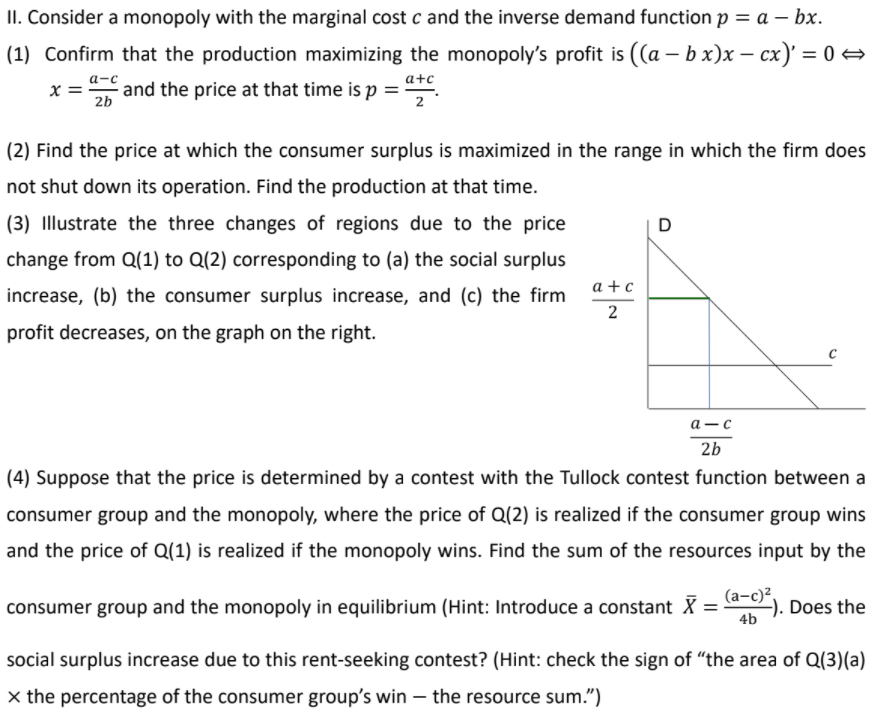II. Consider a monopoly with the marginal cost c and the inverse demand function p = a – bx. (1) Confirm that the production maximizing the monopoly's profit is ((a – b x)x – cx)' = 0 → x = and the price at that time is p =" а-с a+c 2b (2) Find the price at which the consumer surplus is maximized in the range in which the firm does not shut down its operation. Find the production at that time. (3) Illustrate the three changes of regions due to the price D change from Q(1) to Q(2) corresponding to (a) the social surplus a + c increase, (b) the consumer surplus increase, and (c) the firm profit decreases, on the graph on the right. а—с 2b (4) Suppose that the price is determined by a contest with the Tullock contest function between a consumer group and the monopoly, where the price of Q(2) is realized if the consumer group wins and the price of Q(1) is realized if the monopoly wins. Find the sum of the resources input by the consumer group and the monopoly in equilibrium (Hint: Introduce a constant X = ) ), Does the 4b social surplus increase due to this rent-seeking contest? (Hint: check the sign of "the area of Q(3)(a) x the percentage of the consumer group's win – the resource sum.") 2.
II. Consider a monopoly with the marginal cost c and the inverse demand function p = a – bx. (1) Confirm that the production maximizing the monopoly's profit is ((a – b x)x – cx)' = 0 → x = and the price at that time is p =" а-с a+c 2b (2) Find the price at which the consumer surplus is maximized in the range in which the firm does not shut down its operation. Find the production at that time. (3) Illustrate the three changes of regions due to the price D change from Q(1) to Q(2) corresponding to (a) the social surplus a + c increase, (b) the consumer surplus increase, and (c) the firm profit decreases, on the graph on the right. а—с 2b (4) Suppose that the price is determined by a contest with the Tullock contest function between a consumer group and the monopoly, where the price of Q(2) is realized if the consumer group wins and the price of Q(1) is realized if the monopoly wins. Find the sum of the resources input by the consumer group and the monopoly in equilibrium (Hint: Introduce a constant X = ) ), Does the 4b social surplus increase due to this rent-seeking contest? (Hint: check the sign of "the area of Q(3)(a) x the percentage of the consumer group's win – the resource sum.") 2.
Chapter14: Monopoly
Section: Chapter Questions
Problem 14.5P
Related questions
Question
I would like help specifically for question 4 of this problem. Questions 1-3 are provided for context. Thank you.

Transcribed Image Text:II. Consider a monopoly with the marginal cost c and the inverse demand function p = a – bx.
(1) Confirm that the production maximizing the monopoly's profit is ((a – b x)x – cx)' = 0 →
x = and the price at that time is p ="
а-с
a+c
2b
(2) Find the price at which the consumer surplus is maximized in the range in which the firm does
not shut down its operation. Find the production at that time.
(3) Illustrate the three changes of regions due to the price
D
change from Q(1) to Q(2) corresponding to (a) the social surplus
a + c
increase, (b) the consumer surplus increase, and (c) the firm
profit decreases, on the graph on the right.
а—с
2b
(4) Suppose that the price is determined by a contest with the Tullock contest function between a
consumer group and the monopoly, where the price of Q(2) is realized if the consumer group wins
and the price of Q(1) is realized if the monopoly wins. Find the sum of the resources input by the
consumer group and the monopoly in equilibrium (Hint: Introduce a constant X = )
), Does the
4b
social surplus increase due to this rent-seeking contest? (Hint: check the sign of "the area of Q(3)(a)
x the percentage of the consumer group's win – the resource sum.")
2.
Expert Solution
This question has been solved!
Explore an expertly crafted, step-by-step solution for a thorough understanding of key concepts.
Step by step
Solved in 2 steps with 1 images

Knowledge Booster
Learn more about
Need a deep-dive on the concept behind this application? Look no further. Learn more about this topic, economics and related others by exploring similar questions and additional content below.Recommended textbooks for you









Managerial Economics: A Problem Solving Approach
Economics
ISBN:
9781337106665
Author:
Luke M. Froeb, Brian T. McCann, Michael R. Ward, Mike Shor
Publisher:
Cengage Learning